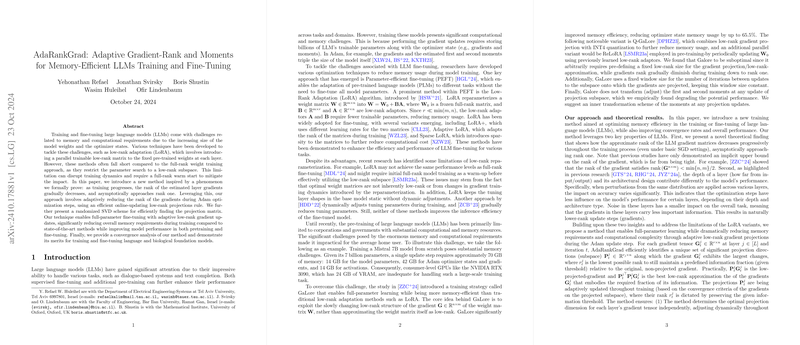AdaRankGrad: Adaptive Gradient-Rank and Moments for Memory-Efficient LLMs Training and Fine-Tuning
The paper "AdaRankGrad: Adaptive Gradient-Rank and Moments for Memory-Efficient LLMs Training and Fine-Tuning" introduces an innovative technique aimed at addressing the challenges associated with training and fine-tuning LLMs. These models, due to their extensive size, bring substantial memory and computational demands, predominantly due to the storage requirements for the model weights and optimizer states. This paper proposes an approach centered around adaptively reducing the rank of the gradients during optimization steps, specifically using Adam, which is traditionally memory-intensive.
Conceptual Framework and Strategy
In traditional training paradigms, methods like Low-Rank Adaptation (LoRA) introduce low-rank matrices to mitigate memory usage. However, such methods restrict parameter optimization to a low-rank subspace, potentially altering training dynamics unfavorably. AdaRankGrad seeks to maintain full-rank training dynamics while leveraging the empirical observation that the effective rank of LLM gradients tends to decrease over training iterations. The authors prove that as training progresses, these gradients asymptotically approach rank one, providing a theoretical grounding for their method.
Technical Implementation
AdaRankGrad implements an online low-rank projection method for the gradients. This involves an adaptive approach where the rank of the projected gradients is dynamically adjusted to preserve a predefined fraction of the gradient's information content. The method adopts a randomized Singular Value Decomposition (SVD) scheme to efficiently compute the projection matrix, thus optimizing memory usage without compromising model performance.
The training process involves four key steps:
- Adaptive Subspace Selection: Utilizing randomized range finding algorithms to determine an optimal low-rank projection for the gradient matrix efficiently.
- Moments Subspaces Transformation: Transforming the optimizer states according to the updated projection subspaces.
- Low-Rank Optimization: Continuously updating the model parameters with projected gradients, ensuring convergence within the adaptive subspace.
- Full-Parameter Update: Applying these updates during the training cycle.
Empirical Evaluation and Results
The paper provides an extensive evaluation on the GLUE benchmark, showcasing improvements in model performance with reduced memory requirements, when compared to both LoRA and GaLore methods. Notably, AdaRankGrad achieves higher accuracy across various tasks while maintaining efficiency in memory usage. The authors also report substantial memory savings when pre-training LLaMA models on the C4 dataset, highlighting AdaRankGrad's applicability to large-scale LLMs.
Implications and Future Directions
AdaRankGrad's approach has significant implications for both theoretical understanding and practical implementation of LLM training. The adaptive nature of the algorithm ensures that memory resources are optimally utilized, potentially enabling the deployment of these large models on consumer-grade hardware. Theoretically, the model offers a deeper look into the gradient dynamics of LLMs, providing pathways for further exploration into low-rank approximation techniques.
Future research could explore extending the AdaRankGrad framework to other optimization methods beyond Adam and investigate alternative algorithms for subspace rank determination. Additionally, the integration of AdaRankGrad with quantization methods could further enhance its efficiency, facilitating more widespread accessibility and deployment of LLMs.
Overall, AdaRankGrad stands as a forward-thinking approach to optimizing LLM training, balancing the demands of computational efficiency and model performance.
